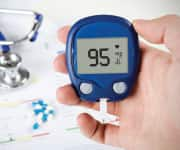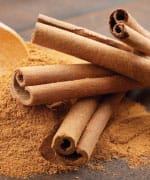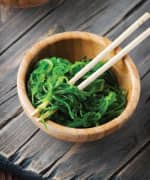Life Extension Magazine®
A staggering number of Americans suffer from a disorder called “metabolic syndrome” that is characterized by a combination of:1
- High blood sugar
- Increased blood pressure
- Abdominal obesity
- Abnormal cholesterol and triglyceride levels
Those with metabolic syndrome are at increased risk for heart attack, stroke, type II diabetes and early death.2
A root cause of metabolic syndrome is insulin resistance.2,3
This article describes natural substances that work together to promote healthy fasting blood sugar and insulin sensitivity.
In the United States there are 86 million adults with prediabetes.4 A substantial number of those with poor glucose control convert to full-blown type II diabetes. Before diabetes is diagnosed, chronically elevated glucose damages tissues throughout the body.
The Power of Prevention
Insulin resistance means the body’s cells cannot respond normally to insulin. That causes blood sugar levels to creep up gradually – entirely without symptoms in most people.
In those with prediabetes or insulin resistance, risk of progression to type II diabetes can be reduced by about 58% with lifestyle interventions, including diet, that lower blood-sugar levels.2 In addition, studies have identified multitargeted nutrients capable of reducing blood glucose via a variety of mechanisms.
What You Need to Know
 |
Targeted Blood-Sugar Control
- More than a third of Americans suffer from metabolic syndrome, which raises their risks of heart disease, stroke, diabetes, cancer, and other life-shortening conditions.
- Metabolic syndrome has many components, but scientists agree that a root cause is insulin resistance.
- Physicians rarely prescribe sugar-lowering drugs to anyone who is not already diabetic, placing millions of Americans at real risk for a host of life-threatening complications.
- Six natural compounds have been shown to work independently and together to prevent blood sugar increases, to enhance insulin sensitivity, and combat the effects of the occasional carbohydrate overindulgence.
- Chromium, amla, shilajit, cinnamon, iodine, and seaweed promote healthy blood sugar levels and prevent insulin resistance through a wide variety of related and complementary mechanisms.
- Any adult, even those with normal blood sugar levels, should consider regular supplementation with these nutrients, to prevent or slow the age-accelerating effects of borderline or high blood sugar by increasing insulin sensitivity, decreasing fasting blood sugar and preventing the effects of the occasional carbohydrate indulgence.
Cinnamon Acts on Multiple Glucose Targets

Cinnamon is an effective tool for lowering blood sugar and reducing the risk of type II diabetes.
A water-soluble, oil-free cinnamon extract has been identified that has demonstrated beneficial effects on blood sugar, glycation, and metabolic syndrome.5,6 The US Department of Agriculture filed a patent application on this extract based on its glucose- lowering properties.7,8
One of the primary ways cinnamon impacts blood sugar is by increasing production of GLUT4, a molecule that is responsible for transporting sugar from blood plasma into the cell, which enhances insulin sensitivity and therefore glucose uptake.9-11
Without effective GLUT4 transporters, sugar levels in the blood steadily rise, eventually producing damage to tissues through the chemical reaction known as glycation, in which glucose molecules bind to vital proteins, deleteriously altering both their structure and function.12
Increased production of PPARs is another critical mechanism of some antidiabetic drugs.13 When activated, PPARs promote insulin sensitivity and glucose uptake. PPARs also suppress fat accumulation and glucose production.13-15
Clinical trials have shown that cinnamon supplementation boosts insulin sensitivity and lowers blood sugar.16-20 Cinnamon also helps to induce satiety, the feeling of fullness after a meal that prevents us from overeating.21 Together, these effects have been shown to reduce evidence of long-term glucose overexposure in blood, as measured by hemoglobin A1C, a measure of chronic exposure to sugar.22
Cinnamon has other properties that help combat metabolic syndrome, such as lowering blood pressure and improving body fat distribution.23,24 Cinnamon has also shown that it could reduce disruptions associated with non-alcoholic fatty liver disease, the liver manifestation of metabolic syndrome.25,26
Lower Blood Sugar With Chromium
Another nutrient that improves blood-sugar levels and insulin sensitivity is chromium.
Studies show there is a powerful connection between chromium and diabetes. For example, people with diabetes and heart disease are relatively deficient in chromium levels, compared with healthy people. And people with known chromium deficiencies develop symptoms associated with type II diabetes.27-33
Human studies show chromium’s impact on both short- and long-term blood-sugar control. When diabetic patients receive chromium supplements, their fasting blood glucose and insulin levels drop promptly, while their long-term sugar levels improve, as indicated by reductions in hemoglobin A1C.34,35
Unlike glucose-lowering drugs and insulin, chromium poses no danger of producing dangerously low blood sugar (hypoglycemia), which is a major advance in safety.36,37
Chromium works in multiple ways to boost glucose uptake from the blood.38 It boosts production of GLUT4 transporter molecules, and triggers the GLUT4 movement from the cell’s interior to its membrane—both of which help move glucose out of the blood and into cells.39-42 This has the dual benefit of lowering blood-sugar levels while providing much-needed chemical energy inside cells.
These glucose uptake-promoting properties mean that chromium fights insulin resistance by enhancing the impact of insulin on a cell’s sugar-absorbing capabilities—and that’s a very good thing for anyone with borderline or high blood sugar.
Ancient Remedies Prevent Tissue Damage

While chromium produces outstanding sugar-lowering effects, it is also a highly reactive metal ion that is capable of inducing oxidative stress that could damage tissue. That’s why scientists now recommend that chromium supplements be stabilized with organic compounds that can reduce the oxidative stress and allow chromium’s major benefits to emerge. Two such compounds are amla and shilajit.
In addition to enhancing chromium’s benefits, these two ancient natural remedies have some impressive protective properties of their own that make them a perfect complement to chromium.
Modern science has revealed that amla extracts powerfully oppose oxidative stress of all kinds. Amla protects against glycation of proteins, which helps prevent the damage that otherwise occurs in tissues throughout the body (eye lens and retina, heart muscle, kidney, nerves, and blood vessels).43,44 Amla also directly prevents blood-sugar levels from rising after a starch-containing meal by blocking the enzymes that convert starch into sugar in the intestine.43 This can help to prevent the effects of the occasional carbohydrate overindulgence and may also help address unhealthy fasting blood-sugar levels.
Shilajit is an adaptogen that helps cells and tissues survive oxidative and other stresses.45 Research shows that shilajit promotes efficient glucose “burning” in mitochondria.46
Efficient-running mitochondria produce fewer chemically stressful byproducts, reducing cell damage. Their energy output is also maximal, helping cells to meet their needs.47 And clean-burning mitochondria are less vulnerable to outside oxidative stress.48,49
Studies show that amla and shilajit provide the tissue protection that is not found in many pharmaceutical drugs.50,51
Providing supplemental chromium stabilized with amla and shilajit is an effective, safe way of lowering blood sugar, minimizing glucose-induced tissue damage, and promoting efficient energy production—all of which are known to mitigate prediabetes and diabetes.
Seaweed Regulates Blood Sugar

Seaweed is a sea vegetable that works in many ways to lower blood sugar and help protect against metabolic syndrome.52-55
Like cinnamon and chromium, seaweed increases levels of the glucose-transporting GLUT4, and increases activity of the energy-sensing PPAR system—both of which promote insulin sensitivity and glucose uptake.56,57
In addition, sea vegetables are rich in iodine, which plays a role in maintaining insulin sensitivity.58 Animal studies have shown that oral supplementation with iodine reduces glucose levels.59,60 And one recent human study showed that in obese, iodine-deficient women, iodine supplements reduced high cholesterol.61
Many of seaweed’s sugar-lowering effects occur directly in the digestive tract. There, seaweed components block the enzymes needed to release sugar molecules from starch.62-66 As a result, glucose is not released, never contributing to rising blood sugar levels.52
Another important way seaweed extracts help combat insulin resistance and metabolic syndrome is by reducing body weight and fat mass. When obese animals were given seaweed supplementation, it was found to lower blood sugar, diminish food intake, reduce body weight, and slow weight gain.67 One reason for these benefits could be because seaweed contains compounds that have been shown to activate systems that cause fat to be burned off rather than stored in the body.68,69
Seaweed supplementation also reduces the development and maturation of new fat cells, which helps prevent weight gain caused by a high fat diet.70,71 As a result, supplemented animals were exposed to far lower levels of the inflammation-promoting molecules (cytokines) that fat tissue pours out into the circulation.72
An Underlying Cause of Insulin Resistance
 |
Insulin resistance, a crucial factor in the development of prediabetes, occurs when the body’s cells cannot respond normally to insulin. That causes blood sugar levels to creep up gradually—and, in most people, entirely without symptoms.74
One of the key dysfunctions in developing insulin resistance is a reduction in movement of glucose-transporting molecules from deep within a cell out to its membrane. These transporters, known as GLUT4, are responsible for transferring sugar from blood plasma into the cell. Once there, its chemical energy is released to keep the cell working.75-77
Without adequate transportation out of the blood and into the cells, sugar is left in the blood, causing blood-sugar levels to steadily rise. Over time, this damages tissues through the chemical reaction known as glycation, which occurs when sugar reacts chemically with vital molecules, including proteins, causing them to become stuck together and preventing them from functioning properly.78
Glycation also creates harmful advanced glycation end products (AGEs), which are known to be a root cause of aging.12
The good news is that if it is caught early enough, insulin resistance can be alleviated. Studies have shown you can reduce the risk of progression from prediabetes to diabetes by about 58% within three years simply through lifestyle interventions.2 And of course, people who already have diabetes need to control their blood-sugar levels just as urgently as those with prediabetes.
That’s why virtually everyone—diabetic or not—can benefit from recent discoveries about multitargeted nutrients capable of improving insulin sensitivity and reducing fasting blood glucose through a variety of mechanisms of action.
Summary

More than one-third of Americans have metabolic syndrome, an insulin-resistant state in which borderline high blood sugar and other metabolic abnormalities signal ever-growing risks for heart disease, stroke, cancer, and a host of other age-accelerating conditions.73
Sugar-lowering drugs are not generally prescribed until after a person develops diabetes, which leaves millions of us in a dangerous, prediabetic state without treatment. Natural supplements have long been shown to reduce the risks of metabolic syndrome by lowering blood-sugar levels before they reach dangerous concentrations.
Cinnamon, chromium, amla, shilajit, and seaweed provide sugar-lowering, energy-burning, and fat-reducing properties, and should be considered as a regular part of a healthy supplement regimen.
While diabetics are well aware of the risks of elevated blood sugar, ultimately anyone—even those with normal blood sugar levels—should be keenly interested in maintaining healthy blood-sugar levels.
If you have any questions on the scientific content of this article, please call a Life Extension® Wellness Specialist at 1-866-864-3027.
References
- Moore JX, Chaudhary N, Akinyemiju T. Metabolic Syndrome Prevalence by Race/Ethnicity and Sex in the United States, National Health and Nutrition Examination Survey, 1988-2012. Preventing Chronic Disease. 2017;14:E24.
- Mayans L. Metabolic Syndrome: Insulin Resistance and Prediabetes. FP Essent. 2015;435:11-6.
- Lam DW, LeRoith D. Metabolic Syndrome. In: De Groot LJ, Chrousos G, Dungan K, et al., eds. Endotext. South Dartmouth (MA): MDText.com, Inc.; 2000.
- Khan T, Tsipas S, Wozniak G. Medical Care Expenditures for Individuals with Prediabetes: The Potential Cost Savings in Reducing the Risk of Developing Diabetes. Popul Health Manag. 2017.
- Lu Z, Jia Q, Wang R, et al. Hypoglycemic activities of A- and B-type procyanidin oligomer-rich extracts from different Cinnamon barks. Phytomedicine. 2010.
- Qin B, Panickar KS, Anderson RA. Cinnamon: potential role in the prevention of insulin resistance, metabolic syndrome, and type 2 diabetes. J Diabetes Sci Technol. 2010;4(3):685-93.
- Available at: https://www.ars.usda.gov/news-events/news/research-news/2000/cinnamon-extract-spices-up-sugar-metabolism/. Accessed April 28, 2017.
- Anderson RA, Broadhurst CL, Polansky MM, et al. Isolation and Characterization of Polyphenol Type-A Polymers from Cinnamon with Insulin-like Biological Activity. Journal of Agricultural and Food Chemistry. 2004;52(1):65-70.
- Kim W, Khil LY, Clark R, et al. Naphthalenemethyl ester derivative of dihydroxyhydrocinnamic acid, a component of cinnamon, increases glucose disposal by enhancing translocation of glucose transporter 4. Diabetologia. 2006;49(10):2437-48.
- Cao H, Polansky MM, Anderson RA. Cinnamon extract and polyphenols affect the expression of tristetraprolin, insulin receptor, and glucose transporter 4 in mouse 3T3-L1 adipocytes. Arch Biochem Biophys. 2007;459(2):214-22.
- Anand P, Murali KY, Tandon V, et al. Insulinotropic effect of cinnamaldehyde on transcriptional regulation of pyruvate kinase, phosphoenolpyruvate carboxykinase, and GLUT4 translocation in experimental diabetic rats. Chem Biol Interact. 2010;186(1):72-81.
- Singh VP, Bali A, Singh N, et al. Advanced glycation end products and diabetic complications. Korean J Physiol Pharmacol. 2014;18(1):1-14.
- Sheng X, Zhang Y, Gong Z, et al. Improved Insulin Resistance and Lipid Metabolism by Cinnamon Extract through Activation of Peroxisome Proliferator-Activated Receptors. PPAR Res. 2008;2008:581348.
- Couturier K, Batandier C, Awada M, et al. Cinnamon improves insulin sensitivity and alters the body composition in an animal model of the metabolic syndrome. Arch Biochem Biophys. 2010;501(1):158-61.
- Kim SH, Choung SY. Antihyperglycemic and antihyperlipidemic action of Cinnamomi Cassiae (Cinnamon bark) extract in C57BL/Ks db/db mice. Arch Pharm Res. 2010;33(2):325-33.
- Solomon TP, Blannin AK. Changes in glucose tolerance and insulin sensitivity following 2 weeks of daily cinnamon ingestion in healthy humans. Eur J Appl Physiol. 2009;105(6):969-76.
- Hlebowicz J, Hlebowicz A, Lindstedt S, et al. Effects of 1 and 3 g cinnamon on gastric emptying, satiety, and postprandial blood glucose, insulin, glucose-dependent insulinotropic polypeptide, glucagon-like peptide 1, and ghrelin concentrations in healthy subjects. Am J Clin Nutr. 2009;89(3):815-21.
- Lu T, Sheng H, Wu J, et al. Cinnamon extract improves fasting blood glucose and glycosylated hemoglobin level in Chinese patients with type 2 diabetes. Nutr Res. 2012;32(6):408-12.
- Magistrelli A, Chezem JC. Effect of ground cinnamon on postprandial blood glucose concentration in normal-weight and obese adults. J Acad Nutr Diet. 2012;112(11):1806-9.
- Bernardo MA, Silva ML, Santos E, et al. Effect of Cinnamon Tea on Postprandial Glucose Concentration. J Diabetes Res. 2015;2015:913651.
- Mettler S, Schwarz I, Colombani PC. Additive postprandial blood glucose-attenuating and satiety-enhancing effect of cinnamon and acetic acid. Nutr Res. 2009;29(10):723-7.
- Crawford P. Effectiveness of cinnamon for lowering hemoglobin A1C in patients with type 2 diabetes: a randomized, controlled trial. J Am Board Fam Med. 2009;22(5):507-12.
- Akilen R, Tsiami A, Devendra D, et al. Glycated haemoglobin and blood pressure-lowering effect of cinnamon in multi-ethnic Type 2 diabetic patients in the UK: a randomized, placebo-controlled, double-blind clinical trial. Diabet Med. 2010;27(10):1159-67.
- Ziegenfuss TN, Hofheins JE, Mendel RW, et al. Effects of a water-soluble cinnamon extract on body composition and features of the metabolic syndrome in pre-diabetic men and women. J Int Soc Sports Nutr. 2006;3:45-53.
- Kim CH, Younossi ZM. Nonalcoholic fatty liver disease: a manifestation of the metabolic syndrome. Cleve Clin J Med. 2008;75(10):721-8.
- Askari F, Rashidkhani B, Hekmatdoost A. Cinnamon may have therapeutic benefits on lipid profile, liver enzymes, insulin resistance, and high-sensitivity C-reactive protein in nonalcoholic fatty liver disease patients. Nutr Res. 2014;34(2):143-8.
- Ding W, Chai Z, Duan P, et al. Serum and urine chromium concentrations in elderly diabetics. Biol Trace Elem Res. 1998;63(3):231-7.
- Ekmekcioglu C, Prohaska C, Pomazal K, et al. Concentrations of seven trace elements in different hematological matrices in patients with type 2 diabetes as compared to healthy controls. Biol Trace Elem Res. 2001;79(3):205-19.
- Morris BW, MacNeil S, Hardisty CA, et al. Chromium homeostasis in patients with type II (NIDDM) diabetes. J Trace Elem Med Biol. 1999;13(1-2):57-61.
- Pineau A, Guillard O, Risse JF. A study of chromium in human cataractous lenses and whole blood of diabetics, senile, and normal population. Biol Trace Elem Res. 1992;32:133-8.
- Jain SK, Patel P, Rogier K. Trivalent chromium inhibits protein glycosylation and lipid peroxidation in high glucose-treated erythrocytes. Antioxid Redox Signal. 2006;8(1-2):238-41.
- Terpilowska S, Zaporowska H. [The role of chromium in cell biology and medicine]. Przegl Lek. 2004;61 Suppl 3:51-4.
- Vincent JB. Mechanisms of chromium action: low-molecular-weight chromium-binding substance. J Am Coll Nutr. 1999;18(1):6-12.
- Pei D, Hsieh CH, Hung YJ, et al. The influence of chromium chloride-containing milk to glycemic control of patients with type 2 diabetes mellitus: a randomized, double-blind, placebo-controlled trial. Metabolism. 2006;55(7):923-7.
- Keszthelyi Z, Past T, Koltai K, et al. [Chromium (III)-ion enhances the utilization of glucose in type-2 diabetes mellitus]. Orv Hetil. 2003;144(42):2073-6.
- Ryan GJ, Wanko NS, Redman AR, et al. Chromium as adjunctive treatment for type 2 diabetes. Ann Pharmacother. 2003;37(6):876-85.
- Cefalu WT, Rood J, Pinsonat P, et al. Characterization of the metabolic and physiologic response to chromium supplementation in subjects with type 2 diabetes mellitus. Metabolism. 2010;59(5):755-62.
- Wang YQ, Yao MH. Effects of chromium picolinate on glucose uptake in insulin-resistant 3T3-L1 adipocytes involve activation of p38 MAPK. J Nutr Biochem. 2009;20(12):982-91.
- Chen WY, Chen CJ, Liu CH, et al. Chromium supplementation enhances insulin signalling in skeletal muscle of obese KK/HlJ diabetic mice. Diabetes Obes Metab. 2009;11(4):293-303.
- Chen G, Liu P, Pattar GR, et al. Chromium activates glucose transporter 4 trafficking and enhances insulin-stimulated glucose transport in 3T3-L1 adipocytes via a cholesterol-dependent mechanism. Mol Endocrinol. 2006;20(4):857-70.
- Wu YT, Sun Z, Che SP, et al. [Regulation of chromium on gene expression of skeletal muscles in diabetic rats]. Wei Sheng Yan Jiu. 2005;34(2):184-7.
- Qiao W, Peng Z, Wang Z, et al. Chromium improves glucose uptake and metabolism through upregulating the mRNA levels of IR, GLUT4, GS, and UCP3 in skeletal muscle cells. Biol Trace Elem Res. 2009;131(2):133-42.
- Nampoothiri SV, Prathapan A, Cherian OL, et al. In vitro antioxidant and inhibitory potential of Terminalia bellerica and Emblica officinalis fruits against LDL oxidation and key enzymes linked to type 2 diabetes. Food Chem Toxicol. 2010.
- Rao TP, Sakaguchi N, Juneja LR, et al. Amla (Emblica officinalis Gaertn.) extracts reduce oxidative stress in streptozotocin-induced diabetic rats. J Med Food. 2005;8(3):362-8.
- Agarwal SP, Khanna R, Karmarkar R, et al. Shilajit: a review. Phytother Res. 2007;21(5):401-5.
- Surapaneni DK, Adapa SR, Preeti K, et al. Shilajit attenuates behavioral symptoms of chronic fatigue syndrome by modulating the hypothalamic-pituitary-adrenal axis and mitochondrial bioenergetics in rats. J Ethnopharmacol. 2012;143(1):91-9.
- Visser SA. Effect of humic substances on mitochondrial respiration and oxidative phosphorylation. Sci Total Environ. 1987;62:347-54.
- Azzam EI, Jay-Gerin JP, Pain D. Ionizing radiation-induced metabolic oxidative stress and prolonged cell injury. Cancer Lett. 2012;327(1-2):48-60.
- Piotrowska D, Dlugosz A, Witkiewicz K, et al. The research on antioxidative properties of TOLPA Peat Preparation and its fractions. Acta Pol Pharm. 2000;57 Suppl:127-9.
- Babu PS, Stanely Mainzen Prince P. Antihyperglycaemic and antioxidant effect of hyponidd, an ayurvedic herbomineral formulation in streptozotocin-induced diabetic rats. J Pharm Pharmacol. 2004;56(11):1435-42.
- Manjunatha S, Jaryal AK, Bijlani RL, et al. Effect of Chyawanprash and vitamin C on glucose tolerance and lipoprotein profile. Indian J Physiol Pharmacol. 2001;45(1):71-9.
- Heo SJ, Hwang JY, Choi JI, et al. Diphlorethohydroxycarmalol isolated from Ishige okamurae, a brown algae, a potent alpha-glucosidase and alpha-amylase inhibitor, alleviates postprandial hyperglycemia in diabetic mice. Eur J Pharmacol. 2009;615(1-3):252-6.
- Lamela M, Anca J, Villar R, et al. Hypoglycemic activity of several seaweed extracts. J Ethnopharmacol. 1989;27(1-2):35-43.
- Iwai K. Antidiabetic and antioxidant effects of polyphenols in brown alga Ecklonia stolonifera in genetically diabetic KK-A(y) mice. Plant Foods Hum Nutr. 2008;63(4):163-9.
- Ruperez P, Ahrazem O, Leal JA. Potential antioxidant capacity of sulfated polysaccharides from the edible marine brown seaweed Fucus vesiculosus. J Agric Food Chem. 2002;50(4):840-5.
- Kim SN, Choi HY, Lee W, et al. Sargaquinoic acid and sargahydroquinoic acid from Sargassum yezoense stimulate adipocyte differentiation through PPARalpha/gamma activation in 3T3-L1 cells. FEBS Lett. 2008;582(23-24):3465-72.
- Kang SI, Jin YJ, Ko HC, et al. Petalonia improves glucose homeostasis in streptozotocin-induced diabetic mice. Biochem Biophys Res Commun. 2008;373(2):265-9.
- Küpper FC, Schweigert N, Gall EA, et al. Iodine uptake in Laminariales involves extracellular, haloperoxidase-mediated oxidation of iodide. Planta. 1998;207(2):163-71.
- Rajendran D, Pattanaik AK, Khan SA, et al. Iodine Supplementation of Leucaena leucocephala Diet for Goats. II. Effects on Blood Metabolites and Thyroid Hormones. Asian-Australas J Anim Sci. 2001;14(6):791-6.
- Nudda A, Battacone G, Bomboi G, et al. Effect of dietary iodine on thyroid hormones and energy blood metabolites in lactating goats. Animal. 2013;7(1):60-5.
- Herter-Aeberli I, Cherkaoui M, El Ansari N, et al. Iodine Supplementation Decreases Hypercholesterolemia in Iodine-Deficient, Overweight Women: A Randomized Controlled Trial. J Nutr. 2015;145(9):2067-75.
- Kim KY, Nguyen TH, Kurihara H, et al. Alpha-glucosidase inhibitory activity of bromophenol purified from the red alga Polyopes lancifolia. J Food Sci. 2010;75(5):H145-50.
- Apostolidis E, Lee CM. In vitro potential of Ascophyllum nodosum phenolic antioxidant-mediated alpha-glucosidase and alpha-amylase inhibition. J Food Sci. 2010;75(3):H97-102.
- Kim KY, Nam KA, Kurihara H, et al. Potent alpha-glucosidase inhibitors purified from the red alga Grateloupia elliptica. Phytochemistry. 2008;69(16):2820-5.
- Zhang J, Tiller C, Shen J, et al. Antidiabetic properties of polysaccharide- and polyphenolic-enriched fractions from the brown seaweed Ascophyllum nodosum. Can J Physiol Pharmacol. 2007;85(11):1116-23.
- Shan X, Liu X, Hao J, et al. In vitro and in vivo hypoglycemic effects of brown algal fucoidans. Int J Biol Macromol. 2016;82:249-55.
- Shimada R, Fujita M, Yuasa M, et al. Oral administration of green algae, Euglena gracilis, inhibits hyperglycemia in OLETF rats, a model of spontaneous type 2 diabetes. Food Funct. 2016;7(11):4655-9.
- Maeda H. Nutraceutical effects of fucoxanthin for obesity and diabetes therapy: a review. J Oleo Sci. 2015;64(2):125-32.
- Lee SH, Ko SC, Kang MC, et al. Octaphlorethol A, a marine algae product, exhibits antidiabetic effects in type 2 diabetic mice by activating AMP-activated protein kinase and upregulating the expression of glucose transporter 4. Food Chem Toxicol. 2016;91:58-64.
- Kang MC, Kang N, Kim SY, et al. Popular edible seaweed, Gelidium amansii prevents against diet-induced obesity. Food Chem Toxicol. 2016;90:181-7.
- Kang MC, Kang N, Ko SC, et al. Anti-obesity effects of seaweeds of Jeju Island on the differentiation of 3T3-L1 preadipocytes and obese mice fed a high-fat diet. Food Chem Toxicol. 2016;90:36-44.
- Oh JH, Kim J, Lee Y. Anti-inflammatory and anti-diabetic effects of brown seaweeds in high-fat diet-induced obese mice. Nutr Res Pract. 2016;10(1):42-8.
- Aguilar M, Bhuket T, Torres S, et al. Prevalence of the metabolic syndrome in the united states, 2003-2012. JAMA. 2015;313(19):1973-4.
- Available at: https://www.ncbi.nlm.nih.gov/pubmed/. Accessed April 28, 2017.
- Eyster CA, Olson AL. Compartmentalization and regulation of insulin signaling to GLUT4 by the cytoskeleton. Vitam Horm. 2009;80:193-215.
- Lauritzen HP. In vivo imaging of GLUT4 translocation. Appl Physiol Nutr Metab. 2009;34(3):420-3.
- Leney SE, Tavare JM. The molecular basis of insulin-stimulated glucose uptake: signalling, trafficking and potential drug targets. J Endocrinol. 2009;203(1):1-18.
- Gkogkolou P, Böhm M. Advanced glycation end products: Key players in skin aging? Dermato-endocrinology. 2012;4(3):259-70.

